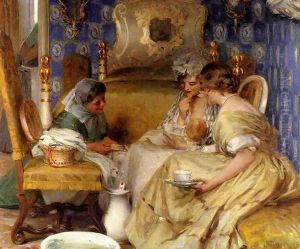Felix Mestres y Borrel Paintings
Felix Mestres y Borrel was a Catalan artist, born on August 24, 1869, in Barcelona, Spain. He was a prominent figure in the Catalan art scene during the late 19th and early 20th centuries. Mestres was primarily known for his paintings, which often depicted historical and religious themes, as well as landscapes and genre scenes. His style was rooted in the academic tradition, although he was also influenced by the innovations of modernisme, the Catalan variant of Art Nouveau that flourished at the turn of the century.
Mestres studied at the Escola de la Llotja in Barcelona, where many notable Spanish artists received their formal education. After completing his studies, he traveled to Rome, which was a common practice among artists of the time who wished to immerse themselves in the classical tradition and the Italian Renaissance. His time in Italy had a profound impact on his artistic development, as he absorbed the techniques and styles of the Italian masters.
Upon his return to Barcelona, Mestres became an active member of the artistic community. He participated in numerous exhibitions and was involved with various artistic societies. His work was well-received, and he gained a reputation for his meticulous approach to painting and his ability to capture the essence of his subjects.
In addition to his painting career, Mestres y Borrel was also a respected teacher, sharing his knowledge and skills with the next generation of artists. He taught at the same institution where he had studied, the Escola de la Llotja, thus contributing to the continuity of the artistic tradition in Barcelona.
Throughout his career, Mestres y Borrel received several awards and honors for his work. Although he may not be as widely recognized today as some of his contemporaries, he remains an important figure in the history of Catalan art. He continued to paint and exhibit his work until his later years, and his legacy is preserved in the collections of various museums and institutions in Spain.
Felix Mestres y Borrel passed away on January 9, 1945, in Barcelona. His contributions to art are remembered for their embodiment of the cultural and historical spirit of Catalonia, as well as for their technical proficiency and aesthetic beauty. His works continue to be studied and appreciated by art historians and enthusiasts who are interested in the development of Spanish art during a period of great cultural change and innovation.
